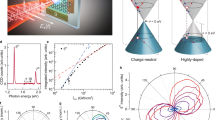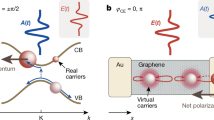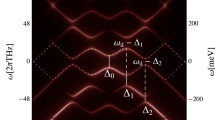Abstract
The ability to steer electrons using the strong electromagnetic field of light has opened up the possibility of controlling electron dynamics on the sub-femtosecond (less than 10−15 seconds) timescale. In dielectrics and semiconductors, various light-field-driven effects have been explored, including high-harmonic generation1,2,3,4, sub-optical-cycle interband population transfer5 and the non-perturbative change of the transient polarizability6,7. In contrast, much less is known about light-field-driven electron dynamics in narrow-bandgap systems or in conductors, in which screening due to free carriers or light absorption hinders the application of strong optical fields6,8. Graphene is a promising platform with which to achieve light-field-driven control of electrons in a conducting material, because of its broadband and ultrafast optical response, weak screening and high damage threshold9,10. Here we show that a current induced in monolayer graphene by two-cycle laser pulses is sensitive to the electric-field waveform, that is, to the exact shape of the optical carrier field of the pulse, which is controlled by the carrier-envelope phase, with a precision on the attosecond (10−18 seconds) timescale. Such a current, dependent on the carrier-envelope phase, shows a striking reversal of the direction of the current as a function of the driving field amplitude at about two volts per nanometre. This reversal indicates a transition of light–matter interaction from the weak-field (photon-driven) regime to the strong-field (light-field-driven) regime, where the intraband dynamics influence interband transitions. We show that in this strong-field regime the electron dynamics are governed by sub-optical-cycle Landau–Zener–Stückelberg interference11, composed of coherent repeated Landau–Zener transitions on the femtosecond timescale. Furthermore, the influence of this sub-optical-cycle interference can be controlled with the laser polarization state. These coherent electron dynamics in graphene take place on a hitherto unexplored timescale, faster than electron–electron scattering (tens of femtoseconds) and electron–phonon scattering (hundreds of femtoseconds)12,13,14. We expect these results to have direct ramifications for band-structure tomography2 and light-field-driven petahertz electronics8.
This is a preview of subscription content, access via your institution
Access options
Access Nature and 54 other Nature Portfolio journals
Get Nature+, our best-value online-access subscription
$29.99 / 30 days
cancel any time
Subscribe to this journal
Receive 51 print issues and online access
$199.00 per year
only $3.90 per issue
Buy this article
- Purchase on Springer Link
- Instant access to full article PDF
Prices may be subject to local taxes which are calculated during checkout




Similar content being viewed by others
References
Ghimire, S. et al. Observation of high-order harmonic generation in a bulk crystal. Nat. Phys. 7, 138–141 (2011)
Vampa, G. et al. Linking high harmonics from gases and solids. Nature 522, 462–464 (2015)
Langer, F. et al. Lightwave-driven quasiparticle collisions on a subcycle timescale. Nature 533, 225–229 (2016)
Golde, D., Meier, T. & Koch, S. W. High harmonics generated in semiconductor nanostructures by the coupled dynamics of optical inter- and intraband excitations. Phys. Rev. B 77, 075330 (2008)
Schultze, M. et al. Attosecond band-gap dynamics in silicon. Science 346, 1348–1352 (2014)
Schiffrin, A. et al. Optical-field-induced current in dielectrics. Nature 493, 70–74 (2012)
Lucchini, M. et al. Attosecond dynamical Franz–Keldysh effect in polycrystalline diamond. Science 353, 916–919 (2016)
Krausz, F. & Stockman, M. I. Attosecond metrology: from electron capture to future signal processing. Nat. Photon. 8, 205–213 (2014)
Castro Neto, A. H., Guinea, F., Peres, N. M. R., Novoselov, K. S. & Geim, A. K. The electronic properties of graphene. Rev. Mod. Phys. 81, 109–162 (2009)
García de Abajo, F. J. G. Graphene plasmonics: challenges and opportunities. ACS Photonics 1, 135–152 (2014)
Shevchenko, S., Ashhab, S. & Nori, F. Landau–Zener–Stückelberg interferometry. Phys. Rep. 492, 1–30 (2010)
Breusing, M. et al. Ultrafast nonequilibrium carrier dynamics in a single graphene layer. Phys. Rev. B 83, 153410 (2011)
Johannsen, J. C. et al. Direct view of hot carrier dynamics in graphene. Phys. Rev. Lett. 111, 027403 (2013)
Gierz, I. et al. Snapshots of non-equilibrium Dirac carrier distributions in graphene. Nat. Mater. 12, 1119–1124 (2013)
Haché, A. et al. Observation of coherently controlled photocurrent in unbiased, bulk GaAs. Phys. Rev. Lett. 78, 306–309 (1997)
Sun, D. et al. Coherent control of ballistic photocurrents in multilayer epitaxial graphene using quantum interference. Nano Lett. 10, 1293–1296 (2010)
Reiss, H. R. Effect of an intense electromagnetic field on a weakly bound system. Phys. Rev. A 22, 1786–1813 (1980)
Wu, M., Ghimire, S., Reis, D. A., Schafer, K. J. & Gaarde, M. B. High-harmonic generation from Bloch electrons in solids. Phys. Rev. A 91, 043839 (2015)
Mücke, O. D., Tritschler, T., Wegener, M., Morgner, U. & Kärtner, F. X. Signatures of carrier-wave Rabi flopping in GaAs. Phys. Rev. Lett. 87, 057401 (2001)
Wismer, M. S., Kruchinin, S. Y., Ciappina, M., Stockman, M. I. & Yakovlev, V. S. Strong-field resonant dynamics in semiconductors. Phys. Rev. Lett. 116, 197401 (2016)
Wachter, G. et al. Controlling ultrafast currents by the nonlinear photogalvanic effect. New J. Phys. 17, 123026 (2015)
Keldysh, L. V. Ionization in the field of a strong electromagnetic wave. Sov. Phys. JETP 20, 1307–1314 (1965)
Ishikawa, K. L. Electronic response of graphene to an ultrashort intense terahertz radiation pulse. New J. Phys. 15, 055021 (2013)
Kelardeh, H. K., Apalkov, V. & Stockman, M. I. Graphene in ultrafast and superstrong laser fields. Phys. Rev. B 91, 045439 (2015)
Oliver, W. D. Mach–Zehnder interferometry in a strongly driven superconducting qubit. Science 310, 1653–1657 (2005)
Kling, S., Salger, T., Grossert, C. & Weitz, M. Atomic Bloch–Zener oscillations and Stückelberg interferometry in optical lattices. Phys. Rev. Lett. 105, 215301 (2010)
Dovzhenko, Y. et al. Nonadiabatic quantum control of a semiconductor charge qubit. Phys. Rev. B 84, 161302 (2011)
Gopal, R. et al. Three-dimensional momentum imaging of electron wave packet interference in few-cycle laser pulses. Phys. Rev. Lett. 103, 053001 (2009)
Arbó, D. G., Ishikawa, K. L., Schiessl, K., Persson, E. & Burgdörfer, J. Intracycle and intercycle interferences in above-threshold ionization: the time grating. Phys. Rev. A 81, 021403 (2010)
Kelardeh, H. K., Apalkov, V. & Stockman, M. I. Attosecond strong-field interferometry in graphene: chirality, singularity, and Berry phase. Phys. Rev. B 93, 155434 (2016)
Acknowledgements
This work has been supported in part by the European Research Council (Consolidator Grant NearFieldAtto) and the Deutsche Forschungsgemeinschaft (grant SFB 953). We thank M. I. Stockman for discussions.
Author information
Authors and Affiliations
Contributions
T.H. and P.H. conceived the study. T.H. and C.H. conveyed the current measurement experiments, analysed the data and provided the plots. K.U. and H.B.W. designed the sample, which was fabricated by K.U. und C.H. T.H. conveyed the numerical simulation. T.H. and P.H. wrote the manuscript with input from all authors. All authors discussed the obtained results.
Corresponding authors
Ethics declarations
Competing interests
The authors declare no competing financial interests.
Additional information
Reviewer Information Nature thanks K. Ishikawa, R. Kienberger and the other anonymous reviewer(s) for their contribution to the peer review of this work.
Publisher's note: Springer Nature remains neutral with regard to jurisdictional claims in published maps and institutional affiliations.
Extended data figures and tables
Extended Data Figure 1 Sample geometry and laser spectrum.
a, Scanning-electron-microscope image of the sample (false-coloured). The graphene strip is aligned parallel to the terrace steps. Scale bar is 2 μm. The triangles found in the electrodes are alignment markers. b, Map of the (CEP-independent) photocurrent as a function of the laser spot position. When the laser spot hits the graphene–metal junction, photo carriers are generated in the graphene that result in a photocurrent owing to the built-in potential at the junction originating from the mismatch of the work functions. c, Laser spectrum, recorded with an optical spectrum analyser. The instrumental noise floor is visible at the spectral extrema. d, Second-harmonics interferometric autocorrelation trace of the compressed laser pulse. The blue circles are measured data points, and the red curve shows a trace calculated from the spectrum assuming a flat spectral phase. The signal is normalized so that the intensity for sufficiently large delay (>40 fs) becomes the unity.
Extended Data Figure 2 CEP-dependent current.
a, CEP-dependent current measured as two-phase lock-in signals Jcos (red markers, in phase) and Jsin (blue markers, quadrature) with the modulation reference frequency fCEO, plotted as a function of relative thickness d of fused silica in the beam path. The maximum optical field strength (at d = 0) is E0 = 2.3 V nm−1. The purple solid envelope curve is a Gaussian fit of the signal amplitude  as a function of d. Red and blue solid curves are fitting curves assuming this Gaussian fit of J0 and the linear shift of the CEP at the sample position as a function of d due to the spectral dispersion in fused silica. The optimal d that maximizes J0 is set to zero. b, Amplitude J0 and phase ϕJ of the CEP-dependent current as a function of fused silica insertion thickness d. ϕJ is defined by Jcos = J0cos(ϕJ) and Jsin = J0sin(ϕJ). The maximum optical field strength is E0 = 2.3 V nm−1. c, d, Amplitude J0 (c) and phase ϕJ (d) of the CEP-dependent current as a function of the optical field strength E0. e, f, Simulation results of J0 (e) and ϕJ (f) are also shown. g, Log–log plot of the numerically obtained J0 as a function of E0, suggesting a power-law scaling of J0 ∝
as a function of d. Red and blue solid curves are fitting curves assuming this Gaussian fit of J0 and the linear shift of the CEP at the sample position as a function of d due to the spectral dispersion in fused silica. The optimal d that maximizes J0 is set to zero. b, Amplitude J0 and phase ϕJ of the CEP-dependent current as a function of fused silica insertion thickness d. ϕJ is defined by Jcos = J0cos(ϕJ) and Jsin = J0sin(ϕJ). The maximum optical field strength is E0 = 2.3 V nm−1. c, d, Amplitude J0 (c) and phase ϕJ (d) of the CEP-dependent current as a function of the optical field strength E0. e, f, Simulation results of J0 (e) and ϕJ (f) are also shown. g, Log–log plot of the numerically obtained J0 as a function of E0, suggesting a power-law scaling of J0 ∝  (dotted line) in the weak-field regime.
(dotted line) in the weak-field regime.
Extended Data Figure 3 Theoretical model for the simulation.
a, Lattice structure of graphene. Two carbon sites A and B reside in a unit cell (green-shaded area). b, Energy difference between the conduction and the valence band obtained from the tight-binding9 model. Panels c and d show the x and y components of the dipole matrix element d(k), respectively.
Extended Data Figure 4 Simulation results with circularly polarized excitation.
a, Difference ΔρCB between the conduction-band populations after excitation by circularly polarized driving pulses with ϕCEP = π/2 and −π/2, shown as a function of the initial wave vector. E0 = 2.3 V nm−1, and the peak field amplitudes of the x and y components of the field are thus E0/ . Solid curves indicate wave vector values corresponding to resonant (multi-) photon absorption. The resonant photon orders are indicated by the numbers. b, Electron trajectories resulting from a circularly polarized pulse with ϕCEP = π/2, starting from two reciprocal points R and S. Green markers indicate the main transition events, which correspond to the peaks in β(t) (see d and Supplementary Methods for definition). The size of the green markers is proportional to
. Solid curves indicate wave vector values corresponding to resonant (multi-) photon absorption. The resonant photon orders are indicated by the numbers. b, Electron trajectories resulting from a circularly polarized pulse with ϕCEP = π/2, starting from two reciprocal points R and S. Green markers indicate the main transition events, which correspond to the peaks in β(t) (see d and Supplementary Methods for definition). The size of the green markers is proportional to  . c, Electric-field waveforms used in the simulations. d, Relative band coupling strength β(t) as function of time for the trajectories starting from R and S. Clearly, for circular polarization the asymmetry in band coupling can explain the CEP-dependence of the current. Intra-optical-cycle quantum-path interference does not show up, which is why the direction of the CEP-dependent current does not change as a function of E0.
. c, Electric-field waveforms used in the simulations. d, Relative band coupling strength β(t) as function of time for the trajectories starting from R and S. Clearly, for circular polarization the asymmetry in band coupling can explain the CEP-dependence of the current. Intra-optical-cycle quantum-path interference does not show up, which is why the direction of the CEP-dependent current does not change as a function of E0.
Extended Data Figure 5 Relative band coupling strengths for linearly polarized excitation.
a, β(t) for the trajectory starting from point P in Fig. 3c under linearly polarized excitation. The electron trajectory is shown in b. Panel c shows β(t) for the trajectory starting from point Q. The peaks of  correspond to the Landau–Zener transitions. Unlike in the circularly polarized case, both a positive and a negative β(t) peak are found per optical cycle, resulting in intra-optical-cycle LSZ interference.
correspond to the Landau–Zener transitions. Unlike in the circularly polarized case, both a positive and a negative β(t) peak are found per optical cycle, resulting in intra-optical-cycle LSZ interference.
Supplementary information
Supplementary Information
This file contains methods 1-11 and references. (PDF 574 kb)
Rights and permissions
About this article
Cite this article
Higuchi, T., Heide, C., Ullmann, K. et al. Light-field-driven currents in graphene. Nature 550, 224–228 (2017). https://doi.org/10.1038/nature23900
Received:
Accepted:
Published:
Issue Date:
DOI: https://doi.org/10.1038/nature23900
This article is cited by
-
Ultrafast, nanoscale control of electrical currents using light
Nature (2024)
-
Sub-cycle multidimensional spectroscopy of strongly correlated materials
Nature Photonics (2024)
-
Light-driven nanoscale vectorial currents
Nature (2024)
-
Light-wave-controlled Haldane model in monolayer hexagonal boron nitride
Nature (2024)
-
Attosecond electron microscopy by free-electron homodyne detection
Nature Photonics (2024)
Comments
By submitting a comment you agree to abide by our Terms and Community Guidelines. If you find something abusive or that does not comply with our terms or guidelines please flag it as inappropriate.



